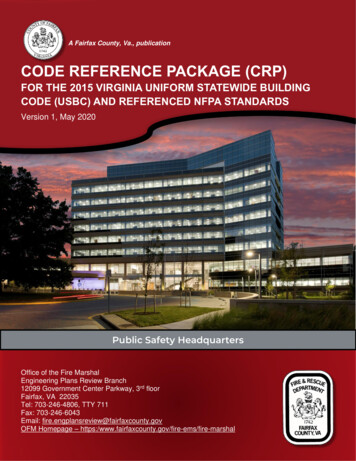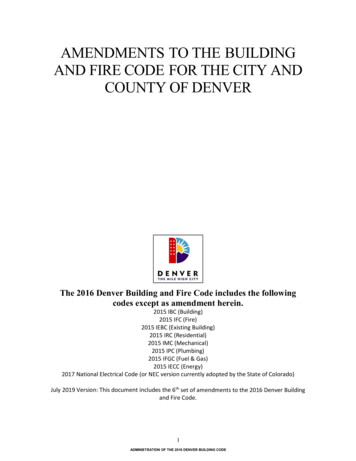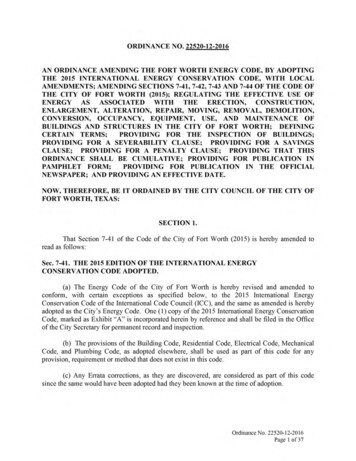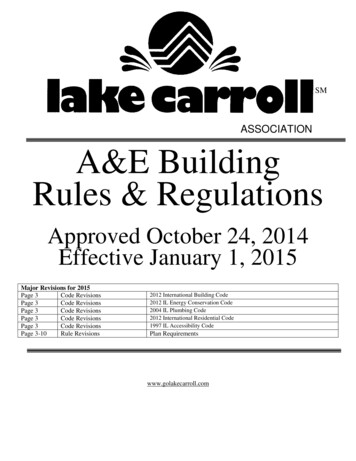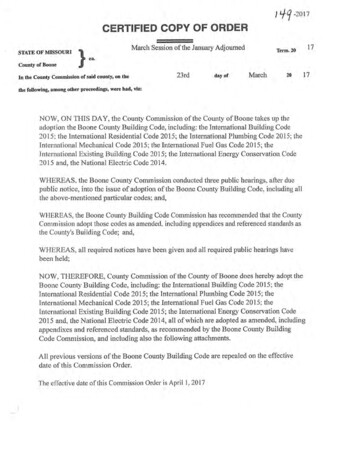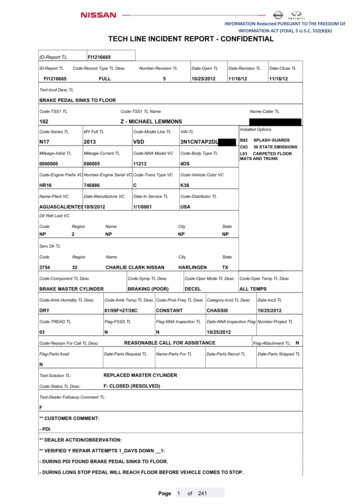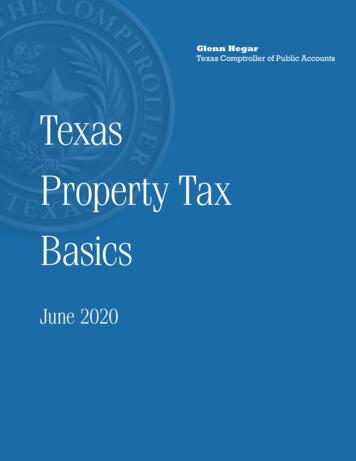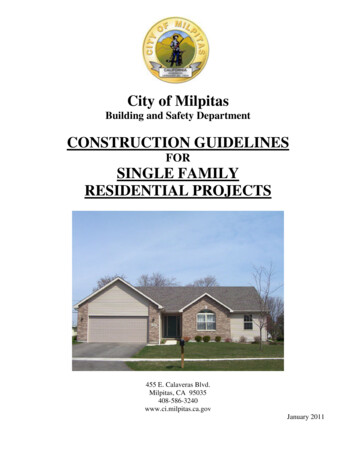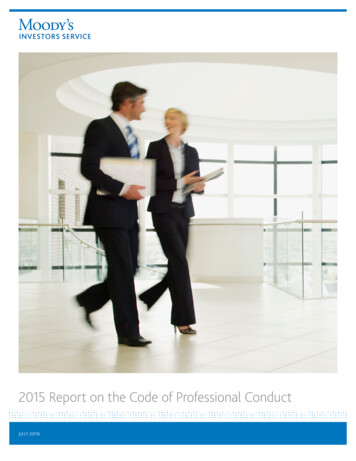
Transcription
2015 Report on the Code of Professional ConductJULY2016MARCH2008
IndexI. Introduction and Background. 2A. Introduction . 2B. Background about MIS. 2C. MIS’s Implementation of the MIS Code. 3D. MIS’s Adherence to Local Laws. 3E. Changes to the MIS Code. 3II. Differences between the MIS Code and the Revised IOSCO Code. 91. Quality and Integrity of the Rating Process. 91.1 Recordkeeping. 91.2 Reviewing the Impact of Changes to Credit Rating Methodologies. 101.3 Disclosing the Withdrawal of Credit Ratings in Certain Circumstances .112. Independence and Avoidance and/or Management of Conflicts of Interest.112.1 Disclosing Conflicts of Interest.112.2 Conducting Analyst Look-Back Reviews. 123. Responsibilities to the Investing Public and Issuers. 123.1 Information Disclosure by Structured Finance Issuers. 123.2 Rating Appeal Process. 133.3 Historical Ratings Performance Information. 133.4 Unsolicited Credit Ratings and Non-Participating Credit Ratings. 143.5 Separation of Research Sales Staff from the Ratings/Research Process. 153.6 Treatment of Confidential Information. 153.7 Confidentiality of Rating Committee Composition and Deliberations. 173.8 Requirements to Report Potential Violations of Laws by Issuers. 174. Governance, Risk Management and Training. 174.1 Oversight Responsibility of the MIS Board. 174.2 Establishment of Risk Management Function. 184.3 Continuing Education. 195. Enforcement and Disclosure of the MIS Code and Communication with Market Participants. 195.1 Implementation of Subjective Standards. 196. Other.206.1 Disclosures to Stakeholders.20III. Enforcement and Disclosure of the Code and Communication with Market Participants.21Annex: Table of Correspondence between the MIS Code and Revised IOSCO Code Provisions. 222015 REPORT ON THE CODE OF PROFESSIONAL CONDUCT 1
I. Introduction and BackgroundA. IntroductionThe Moody’s Investors Service (“MIS”) Code of Professional Conduct (the “MIS Code”) sets out theoverarching principles that guide MIS in its efforts to protect the quality, integrity, objectivity andtransparency of our credit rating process. Through the MIS Code, MIS also seeks to do the following: (i)achieve global consistency;1 (ii) safeguard material non-public information as well as other confidentialinformation either produced by MIS or provided to us by Issuers2; and (iii) promote disclosure about ourrating methodologies, policies, practices and overall track record. We believe these measures will enhancemarket understanding of, and confidence in, our Credit Ratings.The MIS Code largely adopts the provisions of the International Organization of Securities Commissions(“IOSCO”) revised Code of Conduct Fundamentals for Credit Rating Agencies issued in 20153 (“RevisedIOSCO Code”). The Revised IOSCO Code provides a global framework of principles for credit ratingagencies (“CRAs”) and for disclosure by them of their analytical methodologies, rating procedures andrating performance metrics. MIS endorses the Revised IOSCO Code and is committed to implementingit in our organization to the greatest extent possible through the adoption of our own MIS Code. Tomaintain global consistency where appropriate, MIS has also adapted the MIS Code to conform toregulations that apply to our business in the jurisdictions in which MIS operates.MIS first adopted a code of professional conduct in June 2005 and has amended it several times to reflectchanges in the regulatory environment, feedback we have received from users of our Credit Ratings and/or our own deliberations on how the MIS Code can be enhanced.4 In this report, issued pursuant toProvision 5.1 of the MIS Code, we describe (in Section II) the substantive differences between the MISCode and the Revised IOSCO Code, and how we believe MIS has met the Revised IOSCO Code’sobjectives notwithstanding those differences. We also discuss (in Section III) how we enforce the MISCode and make disclosures.This report will be updated as and when amendments are made to the Revised IOSCO Code thatwould require amendments to be made to the MIS Code.B. Background about MISMIS is owned by Moody’s Corporation (“MCO”)5 , a company listed on the New York Stock Exchange.MIS is the oldest bond rating agency in the world, having introduced bond ratings in 1909. MIS hasalways focused on rating debt instruments and MIS continues to publish opinions on a broad range ofcredit obligors and credit obligations issued in markets around the world, including various corporateand governmental obligations, structured finance securities and commercial paper programs.MIS’s Credit Ratings are our current opinions of the relative future credit risk of entities, creditcommitments or debt or debt-like securities. MIS defines credit risk as the risk that an entity may notmeet its contractual, financial obligations as they come due and any estimated financial loss in the eventof default. Credit Ratings do not address any other risk, including but not limited to liquidity risk,market value risk, or price volatility. Credit Ratings are not statements of current or historical fact. CreditRatings do not constitute investment or financial advice, and Credit Ratings are not recommendations123452MIS has country-specific codes in certain jurisdictions where the regulatory frameworks in those jurisdictions require countryspecific provisions to be included in a CRA’s code of conduct.Capitalized terms used but not defined in this Report have the meanings assigned to them in the MIS Code.See 2.pdf.We amended the Code in October 2007, November 2008, August 2010, October 2010, June 2011, December 2013,November 2014 and December 2015.MCO has two operationally and legally separate subsidiaries, MIS and Moody’s Analytics (“MA”). MIS is the CRA, whileMA brings together all of MCO’s other commercial activities.2015 REPORT ON THE CODE OF PROFESSIONAL CONDUCT
to purchase, hold or sell particular securities. Our Credit Ratings do not address the suitability of aninvestment for any particular investor and are intended for use by financial market professionals. MISissues its Credit Ratings with the expectation and understanding that each investor will make its ownstudy and evaluation of each security that is under consideration for purchase, holding, or sale.C. MIS’s Implementation of the MIS CodeMIS continually strives to strengthen the quality and integrity of our rating processes, bolster existingmeasures to manage conflicts of interest, and improve transparency with respect to our Credit Ratingsand our rating processes. Among other things, over the last several years we have revised major policies,committed to review ratings and rating methodologies at least annually, reinforced the operationalsegregation of Credit Rating functions from commercial functions, enhanced disclosures associated withCredit Rating Announcements and strengthened internal control functions.D. MIS’s Adherence to Local LawsThe MIS Code provides that MIS and its Employees will comply with all applicable laws and regulationsgoverning their activities in the jurisdictions in which MIS operates.6 There are countries in whichMIS’s ability to adhere to certain provisions in the Revised IOSCO Code and the MIS Code is limitedby national laws and regulations. To the extent that a provision in the MIS Code is inconsistent withapplicable laws and regulations in a jurisdiction in which MIS operates, that provision in the MIS Codewill not apply in the jurisdiction to the extent of the inconsistency.E. Changes to the MIS CodeMIS made numerous changes to its Code in 2015. These revisions fall into four categories: (1) theaddition of certain definitions to enhance clarity; (2) changes made to align the MIS Code with changesmade to the Revised IOSCO Code; (3) changes made to align the MIS Code with other MIS policies orregulatory requirements; and (4) non-substantive, textual revisions. In the table below we have set forththose changes that fall into the first three categories. We have not included descriptions of those changesthroughout the MIS Code that are non-substantive and textual in nature.With respect to changes made to align the MIS Code with the Revised IOSCO Code, MIS has addedlanguage throughout the MIS Code to make clear that it will “establish, maintain and enforce policiesand controls” relating to a variety of topics. The table below does not specifically address each of theinstances in which such language has been added to the MIS Code.DESCRIPTION OF CHANGETEX T OF REVISIONThe MIS Code contains many termsthat were previously defined in otherMIS policies, procedures and relateddocuments that were referencedby the MIS Code. To enhance theunderstanding of the terms used inthe MIS Code, those terms have nowbeen defined within the MIS Code.The Commercial Group is the department that is responsible forall sales and marketing activities within the rating agency, includingnon-analytic customer service and engagement, as well as productmanagement and business strategy.The MIS Board of Directors (“MIS Board”) refers to the board ofdirectors of Moody’s Investors Service, Inc6See provision 1.12 of the Code.2015 REPORT ON THE CODE OF PROFESSIONAL CONDUCT 3
DESCRIPTION OF CHANGETEX T OF REVISIONNon-Public Information is information that has not been publiclydisseminated (for example, through public filing with a securitiesregulatory authority; issuance of a press release; disclosure of theinformation in a national or broadly disseminated news service; or theissuance of a proxy statement or prospectus).Security(ies) is any non-deposit financial instrument that is, or isderived from, any equity or fixed-income security. This includes, butis not limited to: stocks, bonds, debentures, options, equity securities,convertible securities, warrants, derivative instruments (includingswaps, commodities and futures based on or linked to equity orfixed income securities), notes, collective investment schemes, fixedannuities, variable annuities, open- or closed-end mutual funds,exchange-traded funds and unit investment trusts.The Disclosure Form is a form that contains regulatory disclosuresand is published on MIS’s public website(s) for public Credit Ratingsand in the rating folder of the electronic platform for products suchas Unpublished and Private Monitored Loan Ratings and UnpublishedMonitored Private Placement Ratings at the time a Credit RatingAction is published.An Agent is any party working on behalf of a Rated Entity, or workingon behalf of an agent of the Rated Entity.Fee Discussions are any negotiations about fees for Rating Servicesand any discussions or correspondence (whether internal or external)relating to those negotiations.Form NRSRO is the application filed by MIS with the U.S. Securitiesand Exchange Commission for registration as a Nationally RecognizedStatistical Rating Organization (NRSRO).The language that has been addedto 1.4 and 1.4(a) was previouslycontained in a footnote in the MISCode. By moving this text to thebody of the MIS Code, MIS hasprovided additional clarity regardinghow and on what basis an MISrating is assigned, disseminated andmonitored.42015 REPORT ON THE CODE OF PROFESSIONAL CONDUCT1.4Credit Ratings will be determined by rating committees andnot by any individual Analyst. Once a rating committee hasdetermined the appropriate Credit Ratings to be assigned to aRated Entity’s debt classes (e.g., senior unsecured), or to debtissued under certain specific program documents, MIS willassign such Credit Ratings to such classes unless and until asubsequent rating committee determines otherwise.
DESCRIPTION OF CHANGETEX T OF REVISIONa.Debt issuance by a Rated Entity or under specific programdocuments may be routine (e.g., refinance), or may bematerial to the Rated Entity’s creditworthiness or theprogram structure (e.g., a material change in the RatedEntity’s leverage). It is the responsibility of the Analystto monitor the Issuer’s debt issuance and leverage andchanges to program documents, and to bring materialchanges to the rating committee’s attention. CreditRatings that are:»assigned to securities that are issued over timepursuant to programs, series or categories of debtthat are subject to an existing Credit Rating, or»based on the pass-through of a primary RatedEntity’s Credit Rating,derive their Credit Rating exclusively from the existingCredit Rating of the program, series, category of debtor primary Issuer, as the case may be, and the ratingcommittee for the existing Credit Rating incorporatesfuture issuances into its analysis. Consequently, CreditRating Actions with respect to these Credit Ratings arenot subject to further analysis by a rating committeebeyond the analysis conducted by the original ratingcommittee for the existing Credit Rating.b.In producing a Credit Rating, MIS will consider allinformation known and believed to be relevant by theapplicable Analyst and rating committee about an Issuer,including information received from a source other thanthe Issuer or underwriter that the applicable Analyst andrating committee find credible and potentially significantto a rating decision in a manner generally consistentwith MIS’s published methodologies. MIS will establish,maintain and enforce policies and controls to assurethat the Credit Ratings it disseminates are based on athorough analysis of all such information. In formulatingCredit Ratings, MIS will employ Analysts who, individuallyor collectively (for rating committees), have appropriateknowledge and experience in developing a rating opinionfor the type of Issuer or credit being analyzed.2015 REPORT ON THE CODE OF PROFESSIONAL CONDUCT 5
DESCRIPTION OF CHANGETEX T OF REVISIONThese revisions were made to more1.9closely align the MIS Code to similarchanges made to the Revised IOSCOCode.To address the provision in theRevised IOSCO Code regardingspecific conflicts that should beaddressed by policies and controls,MIS set forth certain conflictsof interest and references to thepolicies MIS has in place to addressthose conflicts. This provision alsoincorporates by reference MIS’sannual Form NRSRO filed withthe U.S. Securities and ExchangeCommission.62015 REPORT ON THE CODE OF PROFESSIONAL CONDUCT2.6MIS will allocate adequate personnel and financial resources tomonitoring and updating its Credit Ratings on a timely basis.Once a Credit Rating is published, and unless it is withdrawn,MIS will:a.at least once in any twelve month period, review thecreditworthiness of the Issuer or other relevant entity orobligation;b.initiate a review of the status of the Credit Ratingupon becoming aware of any information that mightreasonably be expected to result in a Credit RatingAction, including withdrawing a Credit Rating consistentwith the applicable methodologies; andc.update on a timely basis the Credit Rating, as appropriate,based on the results of any such review referred to ina. or b. above. In addition, upon adoption of a new orrevised rating methodology, MIS will review the impactof the new or revised methodology to outstanding CreditRatings and take any necessary Credit Rating Action,within a reasonable period of time.MIS will establish, maintain and enforce policies and controls toidentify and eliminate, or manage and disclose, as appropriate,actual or potential conflicts of interest that may influence thedetermination of Credit Ratings, or the approval of new orrevised Credit Rating.a.MIS is paid by Issuers or underwriters to determine CreditRatings with respect to securities, obligations or moneymarket instruments they issue or underwrite;b.MIS is paid by obligors to determine Credit Ratings ofthose obligors;c.MIS is paid by investors to determine Credit Ratingswith respect to securities, obligations or money marketinstruments;d.in addition to Credit Ratings, MIS provides other services,including but not limited to Rating Assessment Services,to Issuers or obligors that may be subject to a CreditRating by MIS. MIS is paid for these other services by therequesting Issuer or obligor; ande.MIS may issue Credit Ratings covering, and/or requestedby, entities that may have significant financial interest(i.e., 5% or more of outstanding shares) in MCO, MIS’sparent company.
DESCRIPTION OF CHANGETEX T OF REVISIONThe new wording related to nonselective basis was included basedon new wording introduced in theRevised IOSCO Code.3.2MIS will make its public Credit Ratings and public Credit RatingAnnouncements available to the public on a non-selective basiswithout cost, and provide transparency on how the relevantentity or obligation is rated. Such public Credit Ratings andpublic Credit Rating Announcements will be posted on Moody’spublic website(s).a.MIS may also publish on its public website(s) a Credit RatingAction related to a public Credit Rating that is not accompaniedby a Credit Rating Announcement.3.12As a publisher of opinions about credit, MIS reserves the right atany time to issue Unsolicited Credit Ratings if MISThe remainder of the new languagein section 3.2 was added to comportwith other provisions in the RevisedIOSCO Code and MIS operationalprocesses.The changes made to section 3.12were made to align it with changesmade to MIS’s policies regardingthe issuance of Unsolicited CreditRatings.IOSCO introduced a new section4.1into the Revised IOSCO Codeaddressing Governance, RiskManagement and Employee4.2Training. To align the MIS Codeto these new provisions, MIS hasincluded new provisions providingdetails of its governance and risk4.3management frameworks. Inaddition, the provision that hadbeen included in the prior version ofthe MIS Code that related to trainingwas enhanced and moved to thissection.believes:(i)the Unsolicited Credit Rating would provide aninformational benefit market participants; or(ii)the amount of the total debt or debt-like obligationsissued is significant;(iii)the type of security or issue is new to the market; or(iv)the Credit Rating is analytically relevant for other analysisthat MIS provides to the market; and(v)it has sufficient information to support adequate analysisand, if applicable, ongoing monitoring.Business management is responsible for the implementationand the enforcement of the MIS Code. The MIS Board overseesthese responsibilities.MCO has established an Enterprise Risk Management Groupcharged with identifying principal risks across MCO, includingwithin MIS’s businesses.MIS will adopt and maintain an appropriate continuingeducation program for Analysts and will establish, maintainand enforce appropriate policies and controls to verify thatAnalysts undergo required training. Within this continuingeducation program, Analysts will receive training on contentupdates as they emerge and will be required to demonstratetheir understanding of this content via periodic testing. MIS willdesignate one or more appropriate Employees to implementand oversee the continuing education program, The ComplianceDepartment will be responsible for periodic training inconnection with the MCO Code and the MIS Code, as well asother relevant Compliance policies, including those relating tosecurities trading and protection of confidential informationand/or Non-Public Information. The Compliance Departmentalso will establish controls to verify completion of such training.2015 REPORT ON THE CODE OF PROFESSIONAL CONDUCT 7
8DESCRIPTION OF CHANGETEX T OF REVISIONThis provision relating to MIS’scomplaint handling framework wasadded to align the MIS Code withboth the wording in the RevisedIOSCO Code as well as MIS’sinternal policies and regulatoryobligations.5.62015 REPORT ON THE CODE OF PROFESSIONAL CONDUCTMIS will establish, maintain and enforce policies and controlsfor receiving, reviewing, retaining, and handling complaints,including those that are provided on a confidential basis, asset forth in the Policy for the Receipt, Review and Retention ofExternal Complaints. The Compliance Department will conducta review of all relevant complaints in accordance with itspolicies and procedures and will make a determination whetherany further escalation is necessary.
II. Differences between the MIS Code and the RevisedIOSCO CodeSince it was first published in 2005, the structure and substance of the MIS Code has been substantiallysimilar to the IOSCO Code Despite the similarities, there are differences between the MIS Codeand the Revised IOSCO Code. Some of these differences are merely textual, some are different butnot substantive, and some are substantive. The substantive differences address particular aspects ofour rating process, areas not reflected in the Revised IOSCO Code, or our business environment andpractices. In this section of the report, we explain those differences that might be viewed as substantive.Notwithstanding these differences, the MIS Code achieves the objectives of the Revised IOSCO Code.With respect to the changes to the Revised IOSCO Code whereby certain provisions were re-arrangedand combined, corresponding changes have not necessarily been made to the MIS Code. To the extentthat the provisions are contained in the MIS Code (albeit not necessarily in the same order as in theRevised IOSCO Code), these differences are not addressed in this Report.As discussed in the previous section of this Report, in an effort to align the MIS Code with the RevisedIOSCO Code, MIS has added language throughout the MIS Code to make clear that it will “establish,maintain and enforce policies and controls” relating to a variety of topics. While that language is notexactly the same as the language included in the Revised IOSCO Code, we believe it achieves theobjective of making clear that MIS’s Employees are obligated to comply with the MIS Code and that itsprovision are enforced.1. Quality and Integrity of the Rating Process1.1 RECORDKEEPINGREVISED IOSCO CODEMIS CODE1.91.5A CRA should maintain internal recordsthat are accurate and sufficiently detailedand comprehensive to reconstruct thecredit rating process for a given credit ratingaction. The records should be retainedfor as long as necessary to promotethe integrity of the CRA’s credit ratingprocess, including to permit internal audit,compliance, and quality control functionsto review past credit rating actions in orderto carry out the responsibilities of thosefunctions. Further, a CRA should establish,maintain, document, and enforce policies,procedures, and controls designed to ensurethat its employees comply with the CRA’sinternal record maintenance, retention,and disposition requirements and withapplicable laws and regulations governingthe maintenance, retention, and dispositionof CRA records.MIS will comply with its record retention policiesand applicable laws when maintaining recordsused to support its Credit Rating processes. MISwill establish, maintain and enforce policies andcontrols so that its Employees comply with MIS’srecord retention policies and with applicable lawsgoverning retention and disposition of records.MIS Employees will familiarize themselves withMIS’s record retention policies, and periodicallycertify their compliance with such policies.2015 REPORT ON THE CODE OF PROFESSIONAL CONDUCT 9
MIS maintains a record retention policy and procedures that outline the responsibilities of MISEmployees with respect to the creation and retention of records used in the Credit Rating process.Provision 1.5 of the MIS Code, when read with MIS’s record retention policy and procedure, meets theobjectives set out in paragraph 1.9 of the Revised IOSCO Code.1.2 REVIEWING THE IMPACT OF CHANGES TO CREDIT RATING METHODOLOGIESREVISED IOSCO CODEMIS CODE1.151.9A CRA should ensure that sufficientemployees and financial resources areallocated to monitoring and updating allits credit ratings. Except for a credit ratingthat clearly indicates it does not entailongoing surveillance, once a credit ratingis published, the CRA should monitor thecredit rating on an ongoing basis by:a.reviewing the creditworthiness of therated entity or obligation regularly;b.initiating a review of the status ofthe credit rating upon becomingaware of any information that mightreasonably be expected to resultin a credit rating action (includingwithdrawal of a credit rating),consistent with the applicable creditrating methodology;c.reviewing the impact of andapplying a change in the credit ratingmethodologies, models or key ratingassumptions on the relevant creditratings within a reasonable period oftime;d.updating on a timely basis the creditrating, as appropriate, based on theresults of such review; ande.incorporating all cumulativeexperience obtained.MIS will allocate adequate personnel and financialresources to monitoring and updating its CreditRatings on a timely basis. Once a Credit Rating ispublished, and unless it is withdrawn, MIS will:a.at least once in any twelve month period,review the creditworthiness of the Issuer orother relevant entity or obligation;b.initiate a review of the status of theCredit Rating upon becoming aware ofany information that might reasonablybe expected to result in a Credit RatingAction, including withdrawing a CreditRating consistent with the applicablemethodologies; andc.update on a timely basis the Credit Rating,as appropriate, based on the results of anysuch review referred to in a. or b. above. Inaddition, upon adoption of a new or revisedrating methodology, MIS will review theimpact of the new or revised methodologyto outstanding Credit Ratings and take anynecessary Credit Rating Action, within areasonable period of time.Where practicable, MIS will leverage availableinformation and expertise in the monitoring process.MIS will apply changes in relevant key ratingassumptions both to current and newly assigned CreditRatings.While the Revised IOSCO Code refers to “change[s] in the credit rating methodologies, models orkey rating assumptions,” the MIS Code refers only to “new or revised rating methodology[ies].” Thedescription of “methodologies” in the MIS Ratings Symbols and Definition Handbook provides detailson how models and key ratings assumptions form part of MIS’s credit rating analysis. This descriptiongoes further than the definition of “methodologies” in the Revised IOSCO Code so as to retain theinherent flexibility required to reflect different co
2 2015 REPORT ON THE CODE OF PROFESSIONAL CONDUCT I. Introduction and Background A. Introduction The Moody's Investors Service ("MIS") Code of Professional Conduct (the "MIS Code") sets out the overarching principles that guide MIS in its efforts to protect the quality, integrity, objectivity and



